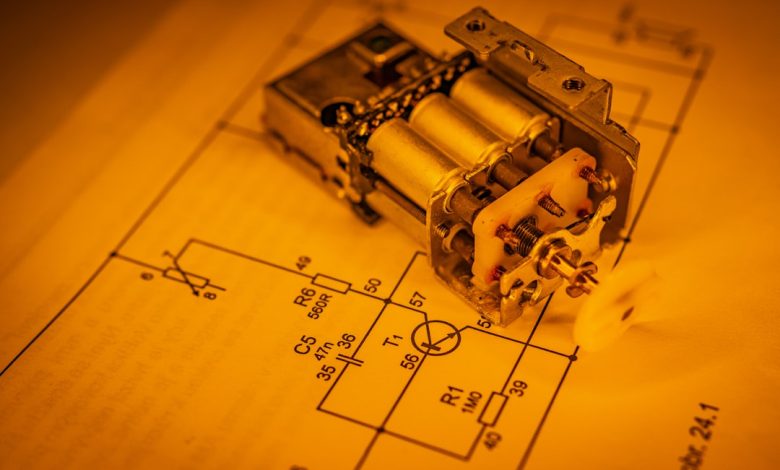Energy Efficiency Analysis of Mining Devices
Energy Efficiency Analysis of Mining Devices

Energy Efficiency Analysis of Mining Devices
As the digital currency landscape continues to evolve, a pressing question arises: Can the mining industry sustain its energy-intensive operations in the long term? The divergence between Bitcoin’s energy-intensive ecosystem and Ethereum’s liquidity-driven DeFi infrastructure in 2025 highlights the pressing need for energy-efficient mining practices.
The mining industry is under scrutiny for its substantial energy consumption, prompting a reevaluation of its practices. With the increasing demand for digital currencies, the importance of energy efficiency in mining equipment has become a critical factor in determining profitability.

Key Takeaways
- The mining industry faces a significant challenge in balancing energy consumption with profitability.
- Energy-efficient mining practices are crucial for the long-term sustainability of the industry.
- The divergence between different digital currencies’ ecosystems affects the overall energy efficiency of mining operations.
- Advancements in mining equipment are necessary to improve energy efficiency.
- The industry’s energy consumption is under scrutiny, prompting a reevaluation of its practices.
The Current State of Energy Consumption in Mining
As the global demand for minerals continues to rise, understanding the current state of energy consumption in mining is crucial. The mining industry is a significant consumer of energy, with various operations contributing to its overall energy footprint.
Global Energy Usage Patterns in Mining Industries
The global energy usage patterns in mining industries vary significantly based on the type of mineral being extracted and the mining method employed. Surface mining, for instance, accounts for over 60% of global coal extraction, reflecting rapid technological advances in the field.
Statistics and Benchmarks
Recent statistics indicate that energy consumption in mining is substantial, with certain operations being more energy-intensive than others. Key benchmarks include:
- Energy consumption per ton of mineral extracted
- Comparative energy usage across different mining methods
- Technological advancements aimed at reducing energy consumption
Regional Variations
Regional variations in energy consumption are significant, influenced by factors such as local energy costs, regulatory environments, and the availability of renewable energy sources. For example, regions with abundant hydroelectric power may have a different energy profile compared to those reliant on fossil fuels.
Understanding these regional variations is crucial for developing targeted strategies to improve energy efficiency in mining operations.
Fundamentals of Energy Efficiency Measurement
Energy efficiency measurement is a key factor in the sustainable development of mining technologies. As the mining industry continues to evolve, understanding and optimizing energy consumption has become increasingly important. Innovative methods have already shown a significant impact, with reductions in environmental impact of up to 30% in underground coal mining since 2020.
Key Performance Indicators for Mining Equipment
To effectively measure energy efficiency, mining operations rely on key performance indicators (KPIs) that provide insights into equipment performance. Two critical KPIs are:
- Energy Consumption Ratio (ECR): This measures the energy consumed per unit of output, helping to identify areas of inefficiency.
- Specific Energy Consumption (SEC): SEC quantifies the energy required to perform a specific task, such as crushing or grinding ore.
Standardized Testing Methodologies
Standardized testing methodologies are essential for ensuring that energy efficiency measurements are accurate and comparable across different mining operations. This involves:
- Laboratory vs. Field Testing: Laboratory testing provides controlled conditions for measuring energy efficiency, while field testing offers real-world data. Both are crucial for a comprehensive understanding.
- Certification Standards: Adhering to certification standards, such as those set by international energy efficiency organizations, ensures that mining equipment meets global best practices.
By focusing on these KPIs and testing methodologies, mining operations can significantly improve their energy efficiency, reducing both operational costs and environmental impact.
Types of Mining Devices and Their Energy Profiles
The mining industry employs a diverse range of devices, each with its unique energy profile. Understanding these energy profiles is crucial for optimizing energy efficiency in mining operations.
Surface Mining Equipment
Surface mining involves the removal of overburden to expose and extract coal deposits. The equipment used in surface mining has significant energy requirements.
Draglines and Excavators
Draglines and excavators are among the primary equipment used in surface mining. Draglines are known for their ability to move large volumes of earth, while excavators are versatile and used for a variety of tasks. Both are energy-intensive, with draglines consuming substantial amounts of electricity.
- Draglines: High energy consumption due to their massive size and operational demands.
- Excavators: Versatile equipment with varying energy consumption based on their size and application.
Haul Trucks and Conveyors
Haul trucks and conveyors are critical for transporting mined materials. Haul trucks are significant consumers of diesel fuel, while conveyors consume electricity. Optimizing their operation can lead to substantial energy savings.
- Haul Trucks: Diesel-powered, with energy consumption dependent on load and distance.
- Conveyors: Electric-powered, with energy consumption influenced by the length and load of the conveyor.
Underground Mining Systems
Underground mining requires specialized equipment designed for operation in confined spaces. The energy profiles of this equipment are critical for efficient underground mining.
Continuous Miners and Longwalls
Continuous miners and longwalls are key equipment in underground mining. Continuous miners are used for extracting coal or other minerals, while longwalls are used for large-scale extraction. Both have high energy demands.
- Continuous Miners: Electric-powered, with high energy consumption for continuous operation.
- Longwalls: Also electric-powered, with significant energy requirements for their operation.
Ventilation and Pumping Systems
Ventilation and pumping systems are essential for maintaining a safe and operational underground mining environment. These systems consume considerable amounts of energy.
- Ventilation Systems: Critical for air quality, with energy consumption dependent on fan size and operation.
- Pumping Systems: Necessary for water removal, with energy consumption influenced by pump size and operational demands.
Understanding the energy profiles of these mining devices is crucial for optimizing energy efficiency and reducing operational costs in both surface and underground mining operations.
Analyzing Energy Efficiency in Mineral Processing Equipment
Energy efficiency analysis in mineral processing is essential for optimizing mining operations and achieving sustainability goals. Mineral processing equipment, including crushing, grinding, and separation technologies, consumes a significant amount of energy.
The efficiency of these processes directly impacts the overall energy consumption and operational costs of mining operations. Modern coal mining focuses on sustainability and emission reduction, making energy efficiency a critical factor.
Crushing and Grinding Technologies
Crushing and grinding are fundamental processes in mineral processing, responsible for a substantial portion of the energy consumed. Different technologies offer varying levels of energy efficiency.
Impact vs. Compression Crushing
Impact crushing and compression crushing are two primary methods used in mineral processing. Impact crushing is often more energy-efficient for certain types of ore, while compression crushing is better suited for others.
- Impact crushing uses high-speed impact forces to break the material.
- Compression crushing applies gradual pressure to crush the ore.
Ball Mills vs. Vertical Mills
Grinding technologies also vary in their energy efficiency. Ball mills are traditional grinding equipment, while vertical mills offer a more energy-efficient alternative.
- Ball mills are widely used but consume a lot of energy.
- Vertical mills are more energy-efficient and offer better grinding performance.
Separation and Concentration Systems
Separation and concentration are critical steps in mineral processing, with various technologies available to optimize energy efficiency.
Flotation Cells
Flotation cells are used to separate minerals based on their surface properties. Energy efficiency in flotation cells can be improved through design optimizations and operational adjustments.
Magnetic and Electrostatic Separators
Magnetic and electrostatic separators are used for separating minerals based on their magnetic and electrical properties. These technologies can be highly energy-efficient when properly optimized.
By analyzing and optimizing the energy efficiency of mineral processing equipment, mining operations can significantly reduce their energy consumption and environmental impact.
Mining Technology and Energy Optimization
The integration of advanced mining technology has revolutionized the industry’s approach to energy optimization. By leveraging cutting-edge innovations, mining operations can significantly reduce their energy consumption and environmental impact.
Automation and Remote Operation
Automation is playing a pivotal role in enhancing energy efficiency in mining. By minimizing the need for human intervention, automated systems reduce the potential for errors and optimize energy usage.
Autonomous Haulage Systems
Autonomous Haulage Systems (AHS) are a prime example of automation in mining. AHS can operate around the clock without breaks, optimizing haulage routes and reducing fuel consumption. This not only improves energy efficiency but also enhances safety.
Remote Control Centers
Remote Control Centers enable operators to manage mining equipment from a distance, reducing the need for personnel to be present in potentially hazardous environments. This technology also allows for real-time monitoring and adjustment of operations to optimize energy use.
Smart Mining Technologies
Smart Mining Technologies incorporate advanced data analytics, IoT devices, and automation to create a more efficient and sustainable mining operation.
IoT Applications
IoT applications in mining enable the real-time monitoring of equipment and processes, allowing for predictive maintenance and the optimization of energy consumption. IoT devices can detect anomalies and alert operators to potential issues before they become major problems.
Real-time Monitoring Systems
Real-time Monitoring Systems utilize data from various sources, including IoT devices and sensors, to provide a comprehensive view of mining operations. This enables operators to make informed decisions and adjust operations to optimize energy efficiency.
AI-based real-time monitoring systems are particularly effective in predictive maintenance and accident prevention, further enhancing the safety and efficiency of mining operations.
| Technology | Energy Saving Potential | Safety Improvement |
|---|---|---|
| Autonomous Haulage Systems | High | Significant |
| Remote Control Centers | Moderate | High |
| IoT Applications | High | Moderate |
Factors Affecting Energy Efficiency in Mining Operations
Achieving energy efficiency in mining requires a comprehensive understanding of operational and site-specific factors. The mining industry, known for its significant energy consumption, must continually assess and optimize its operations to reduce energy waste and improve productivity.

Operational Parameters
Operational parameters play a crucial role in determining the energy efficiency of mining operations. Two key aspects under this category are load factors and utilization rates, and maintenance practices.
Load Factors and Utilization Rates
Optimizing load factors and utilization rates is essential for reducing energy consumption. Efficient load management ensures that equipment operates at or near its optimal capacity, thereby minimizing energy waste. According to industry experts, “effective load management can lead to significant energy savings.”
Maintenance Practices
Regular and proactive maintenance is vital for maintaining the energy efficiency of mining equipment. Predictive maintenance, for instance, allows for the early detection of potential issues, reducing downtime and energy consumption. As noted by a recent study, “predictive maintenance can reduce energy consumption by up to 10%.”
Site-Specific Conditions
Site-specific conditions, including geological characteristics and climate and altitude effects, significantly impact energy efficiency in mining operations.
Geological Characteristics
The geological characteristics of a mining site, such as the hardness of the rock and the depth of the mineral deposit, influence the choice of mining method and equipment, thereby affecting energy efficiency. For example, “mining operations in areas with hard rock formations require more energy-intensive equipment.”
Climate and Altitude Effects
Climate and altitude can also affect energy efficiency. High-altitude mining operations, for instance, may experience reduced equipment efficiency due to lower oxygen levels.
“Mining operations at high altitudes require specialized equipment and strategies to maintain energy efficiency.”
In conclusion, both operational parameters and site-specific conditions are critical factors affecting energy efficiency in mining operations. By understanding and addressing these factors, mining operations can significantly improve their energy efficiency and reduce their environmental footprint.
Economic Analysis of Energy-Efficient Mining
Energy-efficient mining is not just an environmental imperative but also an economic one, with significant implications for mining operations. As mining companies navigate the complexities of reducing energy consumption, they must also consider the economic viability of such practices.
Capital Investment Considerations
The adoption of energy-efficient mining technologies requires substantial capital investment. This includes costs associated with acquiring new equipment and upgrading existing infrastructure.
Equipment Acquisition Costs
The initial outlay for energy-efficient equipment, such as electric and autonomous mining machinery, can be significant. However, these costs are often offset by long-term savings in energy consumption and reduced maintenance needs.
Infrastructure Requirements
Upgrading infrastructure to support energy-efficient mining practices can also incur substantial costs. This includes investments in renewable energy sources and advanced automation technologies.
Operational Cost Implications
Beyond the initial capital investment, energy-efficient mining practices have significant implications for operational costs. These include reductions in energy consumption and changes in maintenance and lifecycle costs.
Energy Cost Savings
One of the primary benefits of energy-efficient mining is the reduction in energy costs. By adopting technologies that consume less energy, mining companies can significantly lower their operational expenses.
Maintenance and Lifecycle Costs
Energy-efficient equipment often requires less maintenance and has a longer lifecycle, further reducing operational costs over time.
In conclusion, the economic analysis of energy-efficient mining reveals that while there are significant upfront costs, the long-term operational savings and environmental benefits make it a viable and attractive strategy for mining companies.
Environmental Impact and Sustainability in Mining
As concern for the environment grows, the mining sector is adopting innovative strategies to minimize its ecological impact. Modern mining practices emphasize sustainable reclamation and environmental monitoring, reflecting a broader commitment to reducing the industry’s carbon footprint.
Carbon Footprint Reduction Strategies
The mining industry is exploring various methods to decrease its environmental impact, including the integration of renewable energy sources and the electrification of mining fleets.
Renewable Energy Integration
Renewable energy can significantly reduce the reliance on fossil fuels, lowering emissions and operational costs. Solar and wind power are becoming increasingly viable options for mining operations.
Electrification of Mining Fleets
Electrifying mining equipment is another strategy to reduce carbon emissions. Electric vehicles and machinery offer a cleaner alternative to traditional diesel-powered equipment.
Regulatory Compliance and Reporting
Mining companies must adhere to stringent environmental regulations and reporting requirements. Compliance is crucial for maintaining operational licenses and public trust.
Emissions Standards
Meeting emissions standards is a key aspect of regulatory compliance. Mining companies are investing in technologies that reduce emissions and improve air quality.
Sustainability Certification
Obtaining sustainability certification is becoming increasingly important for mining companies. It demonstrates a commitment to environmental stewardship and responsible practices.

| Strategy | Description | Benefits |
|---|---|---|
| Renewable Energy | Integration of solar and wind power | Reduced emissions, lower operational costs |
| Electrification | Electric vehicles and machinery | Lower emissions, improved air quality |
| Sustainability Certification | Certification for responsible practices | Enhanced reputation, compliance |
Case Studies: Successful Energy Efficiency Improvements in Mining
Recent case studies highlight the success of energy-efficient practices in large-scale and small to medium mining operations. These improvements not only reduce operational costs but also contribute to a more sustainable mining industry.
Large-Scale Mining Operations
Large-scale mining operations have implemented various energy-efficient technologies to minimize their environmental footprint. For instance, open-pit copper mines have adopted advanced haulage systems that significantly reduce fuel consumption.
Open-Pit Copper Mines
Open-pit copper mines have seen a substantial reduction in energy consumption through the use of electric haulage systems and optimized pit design. This has resulted in lower operational costs and reduced greenhouse gas emissions.
Underground Coal Operations
Innovative ventilation systems and automation technologies have improved energy efficiency in underground coal operations. These advancements have enhanced safety and reduced energy consumption.
| Mining Operation | Energy Efficiency Measure | Impact |
|---|---|---|
| Open-Pit Copper Mines | Electric Haulage Systems | 20% reduction in energy consumption |
| Underground Coal Operations | Innovative Ventilation Systems | 15% reduction in energy consumption |
Small to Medium Mining Enterprises
Small to medium mining enterprises have also benefited from energy-efficient practices, including the adoption of more efficient crushing and grinding technologies.
Aggregate Producers
Aggregate producers have implemented energy-efficient crushing and grinding equipment, resulting in significant cost savings and reduced environmental impact.
Precious Metals Extraction
Precious metals extraction operations have adopted advanced separation and concentration technologies, improving energy efficiency and reducing waste.
These case studies demonstrate the potential for energy efficiency improvements across various mining operations, contributing to a more sustainable and cost-effective industry.
Conclusion
The mining industry is at a critical juncture, where energy efficiency and sustainability are becoming increasingly important. As the industry continues to evolve, it’s clear that sustainable mining practices will play a vital role in reducing environmental impact while maintaining operational effectiveness.
The future of mining lies in adopting technologies and frameworks that combine energy efficiency with sustainable development goals. By doing so, mining companies can minimize their carbon footprint, reduce operational costs, and improve their overall sustainability.
As the industry moves forward, it’s essential to prioritize energy efficiency and sustainability in mining operations. This can be achieved through the adoption of innovative technologies, such as automation and smart mining systems, and by implementing best practices in energy management.
By embracing sustainable mining practices, the industry can ensure a more environmentally friendly and economically viable future.
FAQ
What is the energy efficiency of mining devices?
The energy efficiency of mining devices varies depending on the type of device, its age, and the mining operation. Modern mining equipment is designed to be more energy-efficient, but there is still a wide range of efficiencies across different devices and operations.
How is energy efficiency calculated in mining?
Energy efficiency in mining is typically calculated by measuring the energy consumed by a device or operation and comparing it to the output or production. Key performance indicators such as energy intensity and specific energy consumption are used to evaluate energy efficiency.
What are the most energy-intensive mining operations?
Crushing and grinding operations are among the most energy-intensive in mining, as they require significant amounts of energy to break down and process minerals. Other energy-intensive operations include drilling, excavation, and transportation.
How can automation and smart mining technologies improve energy efficiency?
Automation and smart mining technologies can optimize energy efficiency by optimizing equipment operation, reducing energy waste, and improving predictive maintenance. These technologies can also help to identify areas of inefficiency and provide insights for improvement.
What are the environmental benefits of energy-efficient mining?
Energy-efficient mining can reduce greenhouse gas emissions, minimize environmental impact, and improve sustainability. By reducing energy consumption, mining operations can also reduce their reliance on fossil fuels and lower their carbon footprint.
How can mining companies measure and report their energy efficiency?
Mining companies can measure and report their energy efficiency using standardized metrics and reporting frameworks, such as the Global Reporting Initiative (GRI) or the International Council on Mining and Metals (ICMM) sustainability principles.
What are some examples of successful energy efficiency improvements in mining?
Examples of successful energy efficiency improvements in mining include the use of more efficient equipment, such as electric haul trucks and drills, and the implementation of energy-saving technologies, such as regenerative braking and energy recovery systems.
How can mining companies balance energy efficiency with production demands?
Mining companies can balance energy efficiency with production demands by implementing energy-efficient technologies and practices, optimizing equipment operation, and improving maintenance and repair practices.
What role do regulatory compliance and sustainability certification play in energy-efficient mining?
Regulatory compliance and sustainability certification can drive energy-efficient mining by setting standards and best practices for energy management and sustainability. Certification programs, such as ISO 50001, can also provide a framework for energy management and continuous improvement.
What are the economic benefits of energy-efficient mining?
Energy-efficient mining can reduce operational costs, improve profitability, and enhance competitiveness. By reducing energy consumption, mining companies can also reduce their exposure to energy price volatility and improve their overall sustainability.





